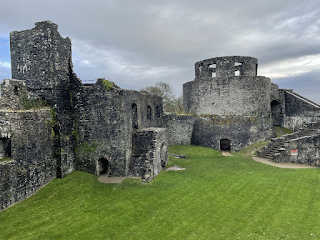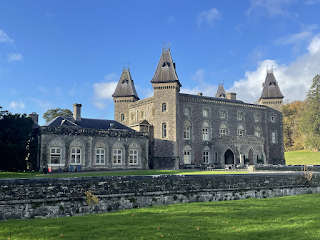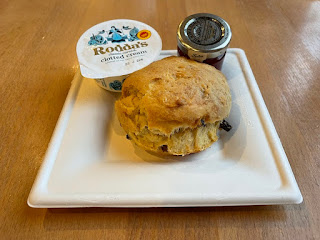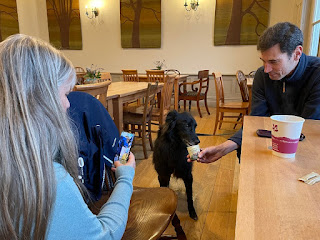But the time had come and I was READY - ready for the 5-hour train journey to the Brecon Beacons, and even more ready for the unavoidable overnight stay, looking forward to the many things I don't get in London - fresh air, total darkness while sleeping, people you don't know saying "morning!" to you etc.
However, I cannot tell you how relieved I was when Corinne, a member of the much beloved National Trust Scone Twitter community, said they'd come with me. By 'they' I mean Corinne, her husband Simon, and my favourite dog in the world, Ole (pronounced Olly).
Before I get on with the history and the all-important scone, I have to tell you that I set off from my little AirBnB in Llandeilo feeling a lot sadder than I expected. I will 1000% continue to visit the National Trust once this project is finished but this was my 243rd visit and it felt like the end of something.
And then, as I walked up the drive towards the house, I was overtaken by Santa. And then another Santa. And then another, until a whole pack of Santas was streaming past me on a fun run. All that was missing was for them to link arms and start singing Always Look on the Bright Side of Life and I'd have thought it was a set-up.
Anyway. Having been reminded not to take things quite so seriously, let me tell you a bit about Dinefwr:
Dinefwr played an important role in Welsh history
Dinefwr in medieval times was the capital of Deheubarth, one of the largest kingdoms in Wales. Deheubarth had been created by Hywel Dda and included Pembrokeshire, the Gower and other parts of South Wales. It was disbanded in 1197, when Rhys ap Gruffudd (otherwise known as the Lord Rhys) died and split his kingdom between his sons. The Lord Rhys had been one of the most powerful figures in the history of Wales, strengthening his power base during times of Anglo-Norman aggression and building trust with Henry II. That all collapsed after Rhys's death.
The ruins of Dinefwr Castle remain
The castle was built in the 13th century. It's thought that Rhys Gryg, grandson of the Lord Rhys, built the round tower and curtain walls. The ruined castle today is not National Trust - it's owned by Cadw, the Welsh version of English Heritage - but you can wander round areas of its ramparts.
Edward I took possession of Dinefwr in 1277
During the conquest of Wales, Edward I took ownership of Dinefwr. Rhys ap Maredudd, the Lord Rhys's great-grandson, tried to take it back but failed and was hanged, drawn and quartered for his efforts.
Gruffydd ap Nicolas acquired Dinefwr but then it went wrong
Gruffydd ap Nicolas took on the lease of Dinefwr in 1440. His grandson, Rhys ap Thomas, sided with Henry during the War of the Roses and the family continued to prosper. But Rhys's son died young and his grandson (also Rhys) made some powerful enemies and ended up being executed for treason. The property was taken by the Crown again.
Walter Rice bought Dinefwr back
Executed Rhys's son, Griffith Rice, was brought up in England, hence the anglicisation of the family name at this point. He started the effort to restore the family's reputation and he succeeded, as his son Walter was knighted by James I. Walter bought Dinefwr castle in 1635. Around 1659 his grandson, Edward, started work on what was to become Newton House:
George Talbot Rice became Baron Dynevor
In 1756, the latest Rice heir married Cecil Talbot, the daughter of Baron Dynevor (the anglicised spelling of Dinefwr). Their son, George Talbot Rice, therefore became the 3rd Baron Dynevor.
Richard Dynevor loved the arts
The ninth Baron Dynevor founded a publishing company, the Black Raven Press, and the Dynevor Arts Festival in the 1960s. He also began negotiations with the National Trust but they proved unsuccessful. The house was sold off before eventually being acquired by the NT in 1990, while Cadw took on the castle.
The Dinefwr Scone
The cafe at Dinefwr is lovely. It's inside the house, with plenty of tables and a relaxed and friendly atmosphere. It also has a serving hatch, for anyone looking for a cup of tea on the go. The scone itself was tasty - it wasn't fresh and it fell apart a bit but it had been well-baked.
Ole, of course, has been pursuing his own project over the past few years, namely National Trust Ice Creams. I'm pleased to report that he wasn't disappointed today and tucked in with great enthusiasm:
It was great that Corinne and Simon were part of today's mission because it gives me a chance to thank them. I think I said it all in my National Trust Scone 2020 Review but I'll repeat it: Ole has been the happiest, loveliest presence in the National Trust Scone Twitter Community for years but in 2020 he upped the ante and basically became my virtual support dog. The photos that Corinne shared of him (Ole doing some decorating, Ole celebrating 75 years since VE day etc) made us all a bit more cheerful during a challenging year. I'm very grateful to Corinne and Simon for sharing him with us, and for coming with me today.
I have to say that Dinefwr was a perfect choice for one of my last National Trust scone visits. It gave me a house, a ruined castle, a large estate for walking, a scone, and a very complicated family history that had my brain twisted into knots - pretty much summing up my NT experience over the past 10 years. It was also a really enjoyable day out with lovely friends that I wouldn't have met without this project.
That's 243 properties completed. I now only have the Giant's Causeway to go. I'll be heading over there in the spring. In the meantime, I'm going to give the blog a winter tidy-up and do some looking back on my adventures so far.
Dinefwr: 5 out of 5
Scone: 4.5 out of 5
Day out with Corinne, Simon and Ole: 500 out of 5
Other Welsh scone missions! Tredegar House, Dyffryn, Aberdulais Tin Works, Plas yn Rhiw, Colby Woodland Garden, Stackpole, Erddig, Chirk Castle, Bodnant Garden, Plas Newydd, Penrhyn Castle, Powis Castle







No comments:
Post a Comment